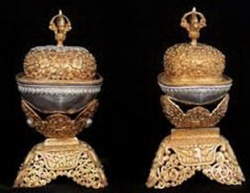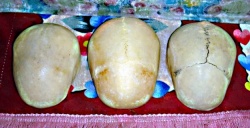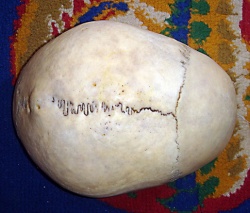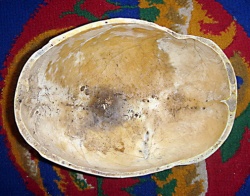Difference between revisions of "The human skull cup"
(Created page with "<poem> The human skull cup, known in Sanskrit as Kapala and in Tibetan as a Thöpa, has extraordinary qualities. It is where the ordinary, munda...") |
|||
| Line 1: | Line 1: | ||
| − | <poem> | + | <poem>[[File:Kapala-0.jpg|thumb|250px|]][[File:11. Grade 1 & 2.JPG|thumb|250px|]][[File:5-Grade 3.JPG|thumb|250px|]][[File:5-Grade 3 Int.JPG|thumb|250px|]] |
The [[human]] [[skull cup]], known in [[Sanskrit]] as [[Kapala]] and in [[Tibetan]] as a [[Thöpa]], has [[extraordinary]] qualities. It is where the ordinary, [[mundane]] and confused [[world]] is [[transformed]] into its [[essential]], [[pure]] [[nature]]. The [[five poisons]] and five [[worldly]] [[elements]] of [[earth]], [[water]], [[fire]], [[air]] and [[space]], become the [[Five Wisdoms]]. This then the [[vehicle]] for making [[pure]] [[offerings]] to [[Buddhas]], [[Yidams]], [[Protectors]], [[Dakinis]] and other [[enlightened]] guests. | The [[human]] [[skull cup]], known in [[Sanskrit]] as [[Kapala]] and in [[Tibetan]] as a [[Thöpa]], has [[extraordinary]] qualities. It is where the ordinary, [[mundane]] and confused [[world]] is [[transformed]] into its [[essential]], [[pure]] [[nature]]. The [[five poisons]] and five [[worldly]] [[elements]] of [[earth]], [[water]], [[fire]], [[air]] and [[space]], become the [[Five Wisdoms]]. This then the [[vehicle]] for making [[pure]] [[offerings]] to [[Buddhas]], [[Yidams]], [[Protectors]], [[Dakinis]] and other [[enlightened]] guests. | ||
Latest revision as of 11:51, 24 October 2013
The human skull cup, known in Sanskrit as Kapala and in Tibetan as a Thöpa, has extraordinary qualities. It is where the ordinary, mundane and confused world is transformed into its essential, pure nature. The five poisons and five worldly elements of earth, water, fire, air and space, become the Five Wisdoms. This then the vehicle for making pure offerings to Buddhas, Yidams, Protectors, Dakinis and other enlightened guests.
The Vajrayana Skull Cup Kapala
It must be understood that the functions and qualities of the skull cup kapala are not just symbolic. They are literal. In fact, eating from a properly prepared skullcup has remarkable effects on the energetic and nutritive qualities of the food itself. This is part of the ancient tantric science that was inherited by the Tibetans, who refined and perfected this alchemical art.
Unlike the human thighbone trumpet or kangling, the color and shades of the bone of the human skull cup or kapala is far more variable. This is due to the varying blood supply and activity of the various brain areas and scalp, the larger, more complex surface area, age, trauma and so on.
Kapala Qualities
Traditional text attribute various characteristics and qualities to these different color and textural differences. The following is from the authoritative “Manual of Sacred Implements” published by the Mindroling Monastery in Southern India:
Acquiring Kapala
Today, it is difficult to find genuine kapala. Skull cups from India and Nepal are very hard to obtain, due to international and national laws. This is because the great majority of these human bone items were from robbed Moslem graves! Legal restrictions cut out this lucrative trade in India, but for Cho, this is a blessing in disguise, as any skull cup of this origin is completely inappropriate for Vajrayana purposes. Similarly, kapalas obtained in Chinese may very well be from political prisoners or executed criminals, including Tibetan nationals. The only place to acquire genuine Buddhist skull cup, kapala or kangling today is from Bhutan.
The origin of this scull cup comes from a tribal remote Bhutanese community of Sakten, located in far Eastern Bhutan. While most Bhutanese cremate their dead bodies as per Buddhist ritual proceedings, these tribal communities feed the dead bodies to the river mammals by cutting them into pieces. It is believed that by feeding their bodies to the water mammals, the dead person’™s soul can achieve nirvana and instant rebirth in one the higher realms.
Kangling and Kapala Fabrication
The process of obtaining the kapala (scull cups) and human thigh bone Kangling trumpet proceeds in a complex and time-consuming process. First, the head and the thigh bone of the corpse are extracted and then being immersed carefully in a select marshy land area for over 3 to 6 months.
It is then exhumed, ensuring that all fleshy portions are completely separated. Any of the local lay monks (ngakpas) can perform the art of separating the skull (Thopa or Kapala) from the head portion and sizing down the thigh bones for kangling. It is then cooked and boiled thoroughly for several days until all the fat content has been removed. Then the final involces cleansing, using sacred, blessed water (amrita or dutsi) and then polishing with baked river sand. This painstaking procedure preserves the original color and all the internal architecture of the kapala skull cup.
Often the brownish dot marks visible inside the cups are not associated with any kind of artificial coloring. During the process of polishing and cleansing the interior portions of the cup, original saffron herb and several blessed amrita liquids are used to cleanse the cup and to determine that the internal portions of the cup are thoroughly cleansed.
The yellowish color inside and outside the scull cup is applied with saffron color to protect humid weather and fungus, which can be cleaned by warm water and any type of mild soap, should one wish to maintain the original color of the cup.
Grading the Kapala Skull Cup
Beneath the outer portion of the cup, one, two or three tiny holes are visible to determine the grading of the scull cups. There are three different categories or grades of skull cups. Scull cups with three SUTURES are third grade (Dumbur Sumpa), two SUTURES are second grade (Dumbur Nyipa) and one single SUTURE (all fused)are graded as grade one (Dumbur Chikpa).



